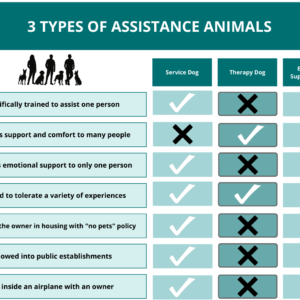Difference between Therapy, Emotional Support and Assistance Dogs

Do you know someone who is interested in searching for an emotional support dog? How about a service or therapy dog? Each of the three types has a different role, and the many terms can be confusing but they aren’t interchangeable.
Owners of dogs often speak about the benefits their pets offer in reducing stress and anxiety, helping them to complete daily tasks much easier. There is often debate about which breeds make the best therapy dog, but the truth is any breed can be trained for therapy work. Instead of focusing on one breed, look for dogs with the right temperament. Service animals should be patient, gentle and affectionate.
Focus on how these wonderful pets make you feel. Let’s define each support animal and how they can help.
WHAT IS AN EMOTIONAL SUPPORT DOG?
Emotional support dogs are defined by their ability to comfort people through affection and companionship. They need to be trained and pass their Canine Good Citizen Test and SMIDT Test. They are a big help to those who suffer from mental and/or emotional issues.
You might be wondering how are they different from other service dogs? Emotional support dogs aren’t required to perform any specific tasks needed to aid a person who is limited by a disability like service dogs are.
Because emotional support animals aren’t required to undergo specialized training, they aren’t allowed access to all public areas. But most notably, you’ve likely seen emotional support dogs flying with someone who has emotional or psychological disabilities. This is common practice as long as a letter is provided from a registered physician.
Their primary role is to provide their owners with emotional comfort. Emotional support animals can psychologically benefit an individual who has a disability tremendously. The gift of companionship and unconditional affection can be just the right therapy to counter a condition like debilitating depression.
Emotional support dogs provide comfort, a calming presence and company. Emotional support dogs do not have access to all public areas, but there are two legal protections. First, they can fly with a person who has an emotional or psychological disability. Second, they can qualify for no-pet housing. A letter from a registred physician may be requested by housing authorities and airlines because the use of emotional support dogs has been abused by some over the years.
There is is formal training needed to be an emotional support dog. They dogs have to be well behaved in public areas. There are organisations who offer the Title of ESD to your dog however they are not certified to accredit those dogs. We offer our Hybrid Course which is online an din person classes.
We want you to have a S.M.A.R.T Dog ever and with the best characteristics. That’s why we do IQ testing already on dogs from 49 days old.
WHAT IS A SERVICE DOG?
A service dog is trained to perform tasks and do work that can help alleviate their owner’s disabilities.
Service dogs are much more than highly trained companions; they have important jobs.

Working as part of a team with their partners, service dogs help attain the safety and independence from which many disabilities would otherwise limit them.
WHAT IS A THERAPY DOG?

Therapy dogs receive extensive training but have a completely different type of job from service dogs.
Their responsibilities are to provide psychological or physiological therapy to individuals other than their handlers, who are usually their owners.
These dogs have stable temperaments and friendly, easy-going personalities. Typically, they visit various institutions like hospitals, schools, hospices, psychotherapy offices, nursing homes and more.
Unlike service dogs, therapy dogs are encouraged to socialize and interact with a variety of people while they’re on-duty.
Make sure your dog is trained by a registered member of the Association of Assistance Dogs Southern Africa. Feel free to contact us for more information or details.

What a remarkable article! The way you’ve tackled the topic with such precision and depth is commendable. Readers are sure to gain a great deal from the wealth of knowledge and practical insights you’ve shared. Your profound understanding of the subject shines through every part of the piece. I’m eager to see more of your exceptional work. Thank you for offering your expertise and providing us with such enlightening and comprehensive content.